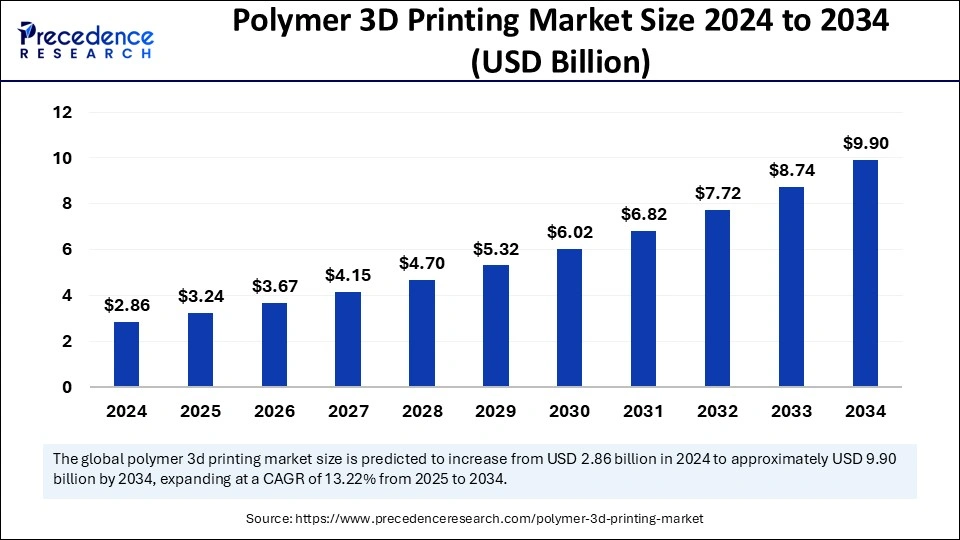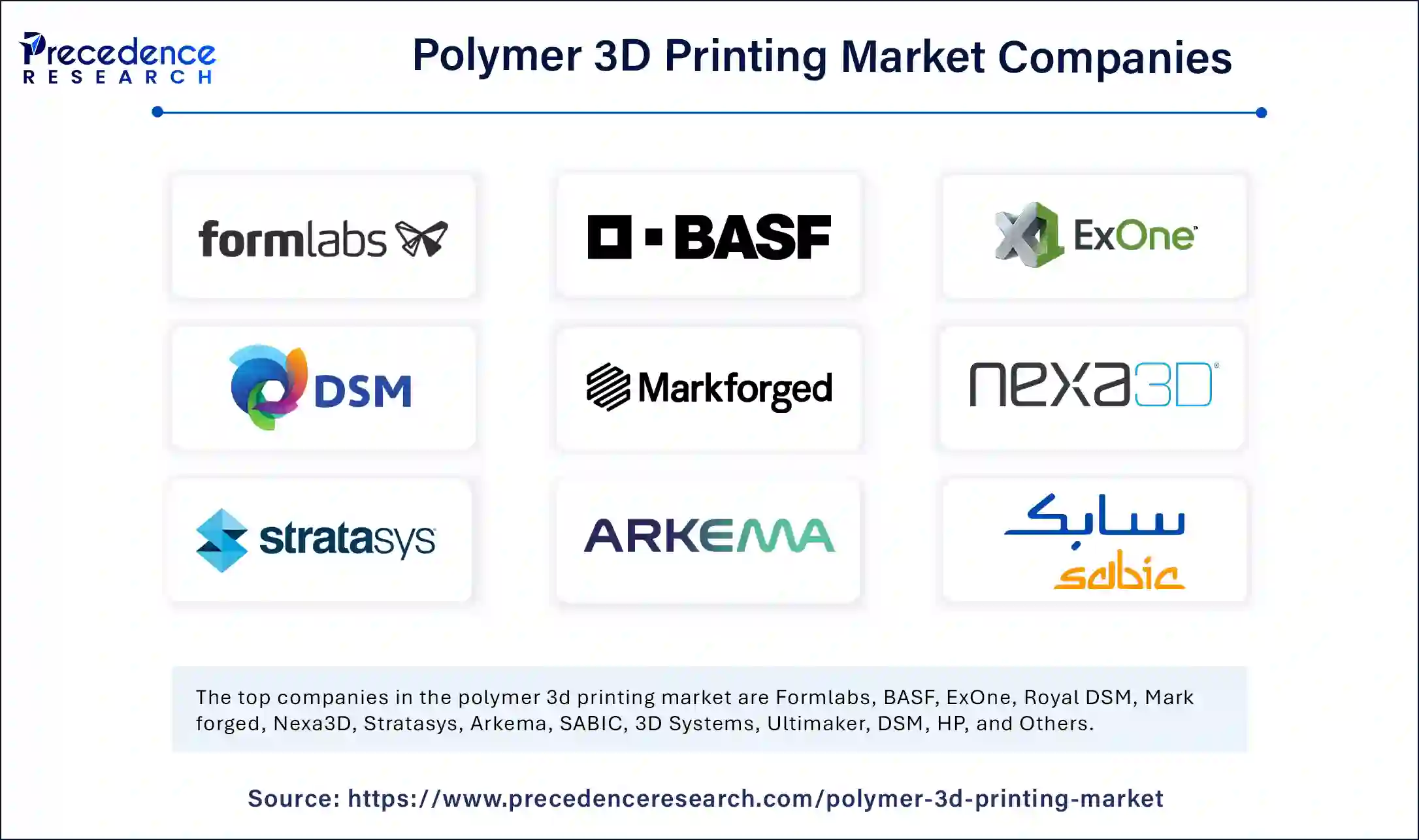Polymer 3D Printing Market Size to Attain USD 9.90 Bn by 2034
Polymer 3D Printing Market Size to Attain USD 9.90 Bn by 2034
The global polymer 3d printing market size is estimated to attain around USD 9.90 billion by 2034 increasing from USD 2.86 billion in 2024, with a CAGR of 13.22%.

Get a Free Sample Copy of the Report@ https://www.precedenceresearch.com/sample/5773
Polymer 3D Printing Market Key Points
-
North America secured the top position in the market with a 41% share in 2024.
-
Asia Pacific is on track to be the fastest-growing region in the coming years.
-
The healthcare industry was the dominant application segment in 2024.
-
The automotive sector is poised for the highest growth rate.
-
Thermoplastics led the material type segment in 2024.
-
Resins are predicted to see the most rapid expansion within the material category.
-
Fuse deposition modeling was the most widely adopted technology in 2024.
-
Stereolithography is expected to witness substantial growth in the forecast period.
-
The prototyping segment was the largest contributor by end-use in 2024.
-
The production sector is forecasted to experience notable market growth ahead.
Polymer 3D Printing: An Overview
Polymer 3D printing is a transformative manufacturing technology that enables the creation of complex and customized polymer-based objects layer by layer. This process utilizes different types of polymer materials, including thermoplastics, photopolymers, and composite polymers, to produce prototypes, functional parts, and end-use products. Due to its versatility, cost-effectiveness, and rapid production capabilities, polymer 3D printing is widely used across industries such as automotive, aerospace, healthcare, and consumer goods.
Types of Polymer 3D Printing Technologies
-
Fused Deposition Modeling (FDM):
-
Uses thermoplastic filaments like PLA, ABS, and PETG.
-
Affordable and widely used for prototyping and functional parts.
-
-
Stereolithography (SLA):
-
Utilizes liquid photopolymer resins that solidify under UV light.
-
Produces high-resolution and detailed parts, ideal for dental and medical applications.
-
-
Selective Laser Sintering (SLS):
-
Works with powdered polymers such as Nylon and TPU.
-
Strong, durable parts with excellent mechanical properties.
-
-
Multi Jet Fusion (MJF):
-
Uses fine polymer powders fused with heat and chemical agents.
-
High-speed production and excellent part strength.
-
-
Digital Light Processing (DLP):
-
Similar to SLA but uses a digital light projector for faster curing.
-
Preferred for intricate and small-scale printing applications.
-
Key Applications of Polymer 3D Printing
-
Automotive & Aerospace: Lightweight and durable components for enhanced performance.
-
Healthcare: Custom prosthetics, implants, and dental models.
-
Consumer Goods: Customized electronics casings, fashion accessories, and footwear.
-
Education & Research: Hands-on learning models and scientific prototypes.
-
Industrial Manufacturing: Rapid prototyping, tooling, and functional testing.
Advantages of Polymer 3D Printing
- Cost-effective for small-batch production and prototyping.
- Enables complex geometries that traditional methods cannot achieve.
- Reduces material waste compared to subtractive manufacturing.
- Enhances customization and design flexibility.
- Shortens product development cycles.
Polymer 3D Printing Market Growth Factors
Technological Advancements in 3D Printing
Continuous innovations in polymer 3D printing technologies, such as high-speed printing, multi-material capabilities, and enhanced precision, are driving market growth. Improvements in additive manufacturing techniques, including stereolithography (SLA), fused deposition modeling (FDM), and selective laser sintering (SLS), enable better-quality production, faster prototyping, and more efficient manufacturing.
Rising Adoption in Healthcare and Medical Applications
The healthcare sector is one of the key drivers of polymer 3D printing, with applications in customized prosthetics, dental implants, surgical models, and bioprinting. The ability to create patient-specific medical devices using biocompatible polymers is accelerating demand in the market.
Growing Use in Automotive and Aerospace Industries
The automotive and aerospace industries are increasingly adopting polymer 3D printing for lightweight component production, rapid prototyping, and customized parts manufacturing. The ability to produce durable yet lightweight polymer-based components contributes to fuel efficiency and overall performance improvements in these industries.
Increased Demand for Sustainable and Biodegradable Polymers
The growing emphasis on sustainability and eco-friendly manufacturing processes is fueling the demand for biodegradable and recycled polymers in 3D printing. Companies are focusing on developing sustainable alternatives to traditional petroleum-based polymers, reducing environmental impact.
Cost-Effectiveness and Material Efficiency
Polymer 3D printing enables manufacturers to reduce material waste, optimize production costs, and achieve greater efficiency compared to traditional subtractive manufacturing methods. The ability to print complex geometries without additional tooling or molds further enhances cost savings for businesses.
Customization and Personalization Trends
The increasing demand for customized products across industries such as consumer goods, fashion, and electronics is propelling the growth of polymer 3D printing. The technology enables mass customization, allowing businesses to produce tailor-made products that cater to individual consumer preferences.
Advancements in Polymer Material Development
The introduction of advanced polymer materials, including high-performance thermoplastics, flexible filaments, and reinforced composites, is expanding the application scope of 3D printing. Innovations in polymer chemistry are enhancing material strength, heat resistance, and durability, making 3D-printed polymer components more viable for end-use applications.
Supportive Government Initiatives and Investments
Governments worldwide are promoting additive manufacturing through funding programs, research initiatives, and regulatory support. Policies encouraging the adoption of digital manufacturing, particularly in defense, aerospace, and healthcare sectors, are fostering market growth.
Expansion of On-Demand Manufacturing and Supply Chain Optimization
Polymer 3D printing is reshaping supply chains by enabling decentralized and on-demand manufacturing. Businesses can produce parts locally, reducing lead times, transportation costs, and dependency on large-scale production facilities, leading to increased market adoption.
Rising Popularity of Consumer 3D Printing
With the growing availability of affordable desktop 3D printers and user-friendly software, consumer adoption of polymer 3D printing is increasing. Applications in DIY projects, personalized accessories, and small-scale manufacturing are contributing to the overall market expansion.
Market Scope
| Report Coverage | Details |
| Market Size by 2034 | USD 9.90 Billion |
| Market Size in 2025 | USD 3.24 Billion |
| Market Size in 2024 | USD 2.86 Billion |
| Market Growth Rate from 2025 to 2034 | CAGR of 13.22% |
| Dominating Region | North America |
| Fastest Growing Region | Asia Pacific |
| Base Year | 2024 |
| Forecast Period | 2025 to 2034 |
| Segments Covered | Application, Material Type, Technology, End-use and Regions. |
| Regions Covered | North America, Europe, Asia-Pacific, Latin America, and Middle East & Africa |
Market Dynamics
Market Drivers
The rising demand for eco-friendly and biodegradable polymers is a key driver of the polymer 3D printing market, as companies seek sustainable manufacturing solutions. The ability to rapidly produce prototypes and functional parts with minimal material wastage is another factor contributing to the increasing adoption of this technology. Additionally, government support for additive manufacturing initiatives and funding for research and development are playing a crucial role in market expansion.
Market Opportunities
New opportunities in mass customization and personalized production are emerging, particularly in the consumer electronics and fashion industries. The advancement of polymer composites with improved mechanical properties is also opening up new applications in defense, aerospace, and construction. Additionally, the integration of artificial intelligence and machine learning in 3D printing is expected to enhance design optimization and printing efficiency.
Market Challenges
Despite its advantages, the polymer 3D printing market faces several challenges, including high equipment costs and the need for specialized training to operate advanced 3D printers. The durability and mechanical strength of 3D-printed polymer parts are also concerns for industries requiring high-performance materials. Moreover, supply chain limitations and material availability continue to impact the scalability of polymer 3D printing.
Regional Insights
North America is the dominant market for polymer 3D printing, driven by strong technological capabilities and investments in additive manufacturing. Europe is also experiencing steady growth, with significant adoption in industrial manufacturing and medical applications. Meanwhile, the Asia Pacific region is expected to witness the fastest growth, led by increasing investments in digital manufacturing and rising demand from key industries such as automotive and consumer electronics.
Polymer 3D Printing Market Companies

- Formlabs
- BASF
- ExOne
- Royal DSM
- Mark forged
- Nexa3D
- Stratasys
- Arkema
- SABIC
- 3D Systems
- Ultimaker
- DSM
- HP
- Evonik
- Materialise
Expert Opinion: Where to Invest in the Polymer 3D Printing Sector?
Bioprinting and Medical Applications
As per market trends, the medical sector is the most lucrative option to expand a business. By investing in biotech firms, hospitals and research institutes can yield greater returns owing to the surge in 3D-printed implants, biocompatible materials, and prosthetics.
Automation and Software
By integrating automation and evolving technologies like AI, ML, and convolutional neural networks (CNNs) with 3D printing, workflows can be streamlined with less human intervention. Moreover, by incorporating software that suggests precise solutions for optimizing material use, printing failures can be reduced.
High-performance Composites and Polymers
By investing in high-quality and advanced materials like polyetherimide (PEI), polyetheretherketone (PEEK), and reinforced composites, businesses in the aerospace, automotive, and medical sectors can gain a competitive edge. Using these materials in 3D printing enables the development of intricate components with fine details. These materials offer high tensile strength and thermal resistance, making them suitable for 3D printing.
Eco-friendly and Sustainable Filaments
Investing in eco-friendly filaments and bio-degradable polymers, like polylactic acid (PLA) and polyhydroxyalkanoates (PHA), that can be recycled easily offers a great opportunity to expand the business, which attracts environmentally conscious consumers.
Segments Covered in the Report
By Application
- Aerospace
- Automotive
- Healthcare
- Consumer goods
- Art and design
By Material Type
- Thermoplastics
- Resins
- Elastomers
- Composites
By Technology
- Fused deposition modeling
- Stereolithography
- Selective laser sintering
- Digital light processing
By End-use
- Prototyping
- Production
- Research and development
By Geography
- North America
- Europe
- Asia Pacific
- Latin America
- Middle East and Africa (MEA)
Also Read: Architectural Metal Coatings Market
Ready for more? Dive into the full experience on our website@ https://www.precedenceresearch.com/
